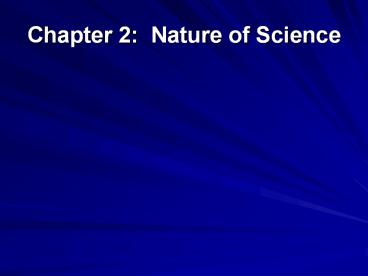Chapter 2: Nature of Science PowerPoint PPT Presentation
1 / 18
Title: Chapter 2: Nature of Science
1
Chapter 2 Nature of Science
2
Chapter 2.1
3
The Scientists Mind
4
3 Scientists, 3 Individuals
- Carl Sagan a noted astronomer popularized
science through books and TV. - Enriqueta Barrera became interested in local
geology while taking walks. Now the director of
Geology at National Science Foundation - Evan Forde 1st African American in the Alvin
(submersible sub.) - All 3 scientists became Earth Scientists due to
curiosity
5
Different lives common Goals
- Scientists will teach research in labs or out in
nature, on or in oceans. - Scientists look at the world in both logic and
curiosity.
6
Qualities of Scientific Thinking
- Scientists are observant they make predictions
based on evidence (materials or data that can be
measured and tested to verify a prediction) - Hypothesis a tentative explanation for an
observation of phenomenon
7
- Must be skeptical they question long-held
assumptions and try to prove or disprove ideas - Technology is the practical application of
science to meet human needs. - The object of scientific study is to understand
the natural world.
8
Chapter 2.2
9
Scientific Methods of Inquiry
- Creativity plays a large role in science along
with logic - Being able to test ideas with experiments is the
key to much of science
10
How scientists approach questions
- Scientific Inquiry - which involves observing,
asking questions, forming a hypothesis, gathering
data testing the hypothesis, and sharing what has
been learned
11
Peer Review and Scientific Journals
- After the experiment the new knowledge needs to
be shared with and tested by other scientists - To share the knowledge Scientific Journals are
used - If the experts agree the paper has merit, it my
be published - If the experts feel the scientist has not done
enough to prove her point it is not published and
sent back with suggestions
12
Importance of testing Ideas
- Some advances that look promising fall short when
tested - E.g. cold fusion HH He
13
Scientific Theories and Laws
- Theory is an explanation of observable events or
facts for which no exception has been found - Theories rise and fall from favor and new
information comes to light. - Scientific law a re generalizations about how
the natural world behaves under certain
conditions - No exceptions have ever been found
14
Chapter 2.3
15
Scientists Tools
16
Geology
- Rock hammer used to collect specimens in the
field - Soil augers pulls up a sample of soil
- Crushers to pulverize materials to study
- Range finders distance
- Seismographs to determine composition of rock
below ground
17
Tools to study Sky and Stars
- Meteorologist
- Thermometers
- Arco vane wind speed and direction
- Radar and satellites
- Astronomer
- Telescopes - light, radio, x-rays, infrared
18
Tools with many uses
- Computers and satellites have revolutionized
earth science

